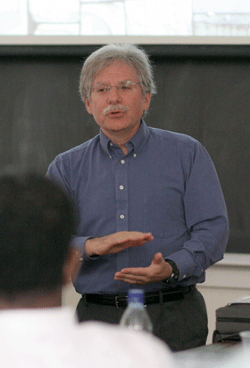When Professor of English Warren Rosenberg went to Poland for the first time in August, he embarked on a trip of reflection, discovery, and healing. He chronicled the struggles he experienced throughout his trip through pictures, stories, and original poetry at the October 16 Humanities Colloquium he titled: "Holocaust Dreams: An American Jew ‘Returns’ to Poland. Although it was his first trip to Poland he dubbed it as a "return" in the sense he would be returning to where his family originated.
Rosenberg, the descendant of a Polish Jew, wrestled with the idea of visiting Poland. He knew it would evoke even stronger feelings of frustration and hurt than he had experienced from studying the Holocaust through books and photos. He recalled having a knot in his stomach for months before he left and then being physically ill approaching different destinations of his journey. At the same time he knew he needed to go on this "Jewish legacy pilgrimage," in a way his own immersion learning trip.
 He began his trip at a conference in Szczecin, Poland, with colleague English Professor Agata Szczeszak-Brewer and her husband Josh. He then traveled through the country making several stops along the way. He described his feelings during one overnight train tripped packed into a sleeper car with Agata, Josh and a family of four.
He began his trip at a conference in Szczecin, Poland, with colleague English Professor Agata Szczeszak-Brewer and her husband Josh. He then traveled through the country making several stops along the way. He described his feelings during one overnight train tripped packed into a sleeper car with Agata, Josh and a family of four.
As they passed near Auschwitz Rosenberg recalled he couldn’t help but think about all of the Jews throughout Europe who had once been packed onto trains and shipped to concentration camps so close to where they were that very night.
While visiting the concentration camp he came to the glass box filled with hundreds and hundreds of pairs of shoes the Jews were forced to give up along with all of their other belongings. It was there that he felt "confronted with the individualism of the victims."
"There was a pair of blue sandals with a colorful striped strap that looks like something that could so easily be purchased today," he said. "I began thinking about the woman who got up one day and chose to wear those shoes. She had a name, a life, a story."
He found himself emotionally moved throughout his journey at the realness of the historical places and faces he had seen so many times before in photos. As he stood at the "death gate" at Auschwitz he wondered the thoughts of the men and women who had also stood there. "Many of them took their last breaths only moments after those very photos were taken," he said.
All of the emotion and struggles he experienced on that journey only strengthened his belief in the need for immersion learning. The places he visited and the paths he explored brought to life the photos and stories he had pored over for years. Those photos and stories became the preparation that allowed him to experience the trip in a less superficial way. Similarly he wants his students to be well prepared leading up to their own immersion trips. It helps them experience the history and culture of a given region in a very real way.
After he shared his photos, told a few of his stories, and recalled his overwhelmingly emotional response to the journey, he closed his thoughts. "Thank you for being a safe community with which I felt I could share this."